New pool owner so I apologize in advance for using any wrong terminology. Pool was originally built about 20 years ago. Recently advised by our pool service company that we ought to replace our pump due to bearings going out (it was making a very loud whining kind of noise). Previous pump was a 4-year old Pentair WhisperFlo WF26 (single speed, 3,450 rpm). Pool company provided following options: Replace existing pump motor, replace existing pump with same model, replace existing pump with IntelliFlo VSF (explained opportunities for cost savings due to variable speed / variable flow capability). We went with the VSF and it was installed about three weeks ago. We also replaced two Pentair valve actuators (on suction and return lines) and check valve internals (return lines). We previously replaced the heater (AquaCal SQ225), added a Pentair EasyTouch control system, and had the pool resurfaced.
Now to the issues. This past week we used the heater for the first time with the new pump. The heater failed with flow fault codes (I was not in town at the time; pool being used by family guests). Our guests informed our service tech of the issue (same tech that installed the pump), and he told them the heater wasn't getting enough flow and to crank up the pump speed. When they informed me of this I checked out the system remotely via the ScrenLogic app. The data indicated the pump was running at 2,750 RPM and pushing only 21 GPM. They had cranked the pump up to max (3,450 RPM) and it was only pushing 28 GPM (still not enough flow for heater; the heater requires a flow range between 30 and 70 GPM). I followed up with the service tech and he told me it is a heater issue! For the past 16 months the heater worked fine with the former pump, and given that it is a fairly new heater (16 mos) this made no sense to me, so I have been trying to figure out why there is a flow issue. I looked at photos I had taken before and after and notice that the plumbing from the pump to the filter had been changed; it is now a longer run and has an additional 90 elbow. Can this be a contributing factor? Note, the manual heater bypass valve is in the same position it was with the old pump. Any other insights as to why the pump seems to be pushing about half the GPM that it ought to be pushing at specific RPMs?
I also spoke reached out to the owner of the pool company and his response to me was that "the new pump will int be capable of reaching the published maximum GPH (I believe he meant GPM) due to the pre-existing suction and return plumbing size." I also share that this was the same pool builder that built the pool originally 20 years ago, so my follow up question to him will be why suggest a pump that can't reach spec due to existing plumbing conditions, but that's another story!
Thanks.
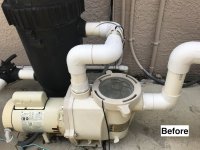
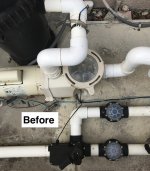
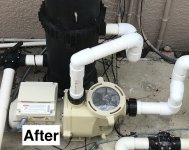
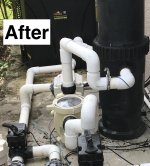
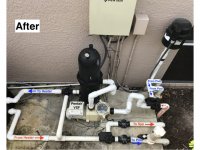
Now to the issues. This past week we used the heater for the first time with the new pump. The heater failed with flow fault codes (I was not in town at the time; pool being used by family guests). Our guests informed our service tech of the issue (same tech that installed the pump), and he told them the heater wasn't getting enough flow and to crank up the pump speed. When they informed me of this I checked out the system remotely via the ScrenLogic app. The data indicated the pump was running at 2,750 RPM and pushing only 21 GPM. They had cranked the pump up to max (3,450 RPM) and it was only pushing 28 GPM (still not enough flow for heater; the heater requires a flow range between 30 and 70 GPM). I followed up with the service tech and he told me it is a heater issue! For the past 16 months the heater worked fine with the former pump, and given that it is a fairly new heater (16 mos) this made no sense to me, so I have been trying to figure out why there is a flow issue. I looked at photos I had taken before and after and notice that the plumbing from the pump to the filter had been changed; it is now a longer run and has an additional 90 elbow. Can this be a contributing factor? Note, the manual heater bypass valve is in the same position it was with the old pump. Any other insights as to why the pump seems to be pushing about half the GPM that it ought to be pushing at specific RPMs?
I also spoke reached out to the owner of the pool company and his response to me was that "the new pump will int be capable of reaching the published maximum GPH (I believe he meant GPM) due to the pre-existing suction and return plumbing size." I also share that this was the same pool builder that built the pool originally 20 years ago, so my follow up question to him will be why suggest a pump that can't reach spec due to existing plumbing conditions, but that's another story!
Thanks.






